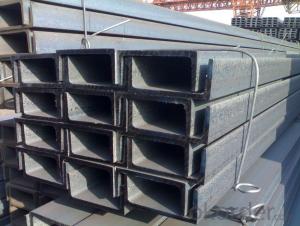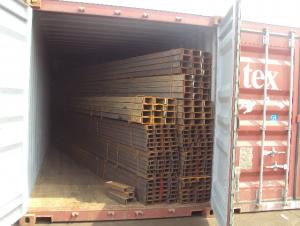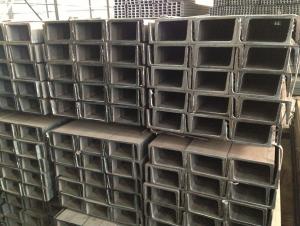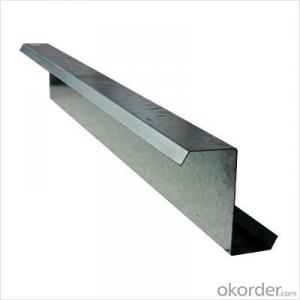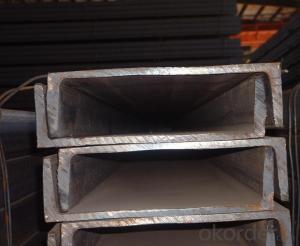Steel U Channel With Higher Yield Point
- Loading Port:
- China main port
- Payment Terms:
- TT or LC
- Min Order Qty:
- 50 m.t.
- Supply Capability:
- 50000 m.t./month
OKorder Service Pledge
OKorder Financial Service
You Might Also Like
Description
In the production of steel products, steel is molded and reshaped with different machinery at different temperatures. One process is steel rolling, which involves metal stock passing through a pair of rolls. Rolling produces flat steel sheets of a specific thickness, and the process is classified according to the temperature at which the metal is rolled. If the temperature of the metal is above its recrystallization temperature, or the temperature at which the grain structure of the metal can be altered, then the process is termed as hot rolling. If the temperature of the metal is below its recrystallization temperature, the process is termed as cold rolling.
Like cold rolling, cold drawing is performed at room temperature, but instead of producing a flat object like a coke can, cold drawing makes steel into the form of a wire like the spokes of a wheel or a paper clip. To start the process, Steel is usual hammered and rolled so that it can be fit through a die; a tool that turns the steel mass into a wire. The room temperature steel is pulled through the die which reshapes it into a thinner shape while maintaining the same volume. It is similar to the idea of syrup flowing out of a bottle through a tube in that it changes shape but not volume, but instead of squeezing the metal, it is pulled out. In order to get the wire down to the right diameter, it usually requires more than one pass through different dies.
Chemical Compostion
Grade | Element(%) | |||
C | Mn | P | S | |
SS330 | -- | -- | ≦0.050 | ≦0.050 |
SS400 | ||||
SS490 | ||||
SS540 | ≦0.30 | ≦1.60 | ≦0.040 | ≦0.040 |
Usage/Applications
Channel Steel is usually used for building structure, vehicle manufacturing and other industrial structure and often used with i beam.
In details, the channel steel belongs to carbon structural steel which is applied to in the field of construction and machinery. The channel steel is usually used for arch-itechtural structure, and they could be welded in order to support or hang a vari-ety of facilities. They are also usually used in combination with I beam. Generally,the channel steel must possess perfect welding property, riveting property and mechanical property and so on.
FAQ:
Q1: Why buy Materials & Equipment from OKorder.com?
A1: All products offered byOKorder.com are carefully selected from China's most reliable manufacturing enterprises. Through its ISO certifications, OKorder.com adheres to the highest standards and a commitment to supply chain safety and customer satisfaction.
Q2: How do we guarantee the quality of our products?
A2: We have established an advanced quality management system which conducts strict quality tests at every step, from raw materials to the final product. At the same time, we provide extensive follow-up service assurances as required.
Q3: Can stainless steel rust?
A3: Stainless does not "rust" as you think of regular steel rusting with a red oxide on the surface that flakes off. If you see red rust it is probably due to some iron particles that have contaminated the surface of the stainless steel and it is these iron particles that are rusting. Look at the source of the rusting and see if you can remove it from the surface.
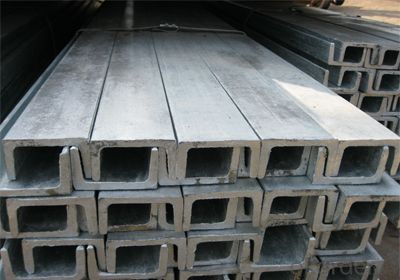

- Q:What are the different methods of protecting steel channels from corrosion?
- There are several methods available for protecting steel channels from corrosion. These methods can be categorized into surface coatings, cathodic protection, and alloying. Surface coatings are one of the most common methods used to protect steel channels from corrosion. These coatings create a barrier between the steel and the corrosive environment, preventing direct contact and thus inhibiting corrosion. Some commonly used surface coatings include paint, epoxy, zinc-rich coatings, and galvanizing. Cathodic protection is another effective method for protecting steel channels from corrosion. It involves introducing a sacrificial anode, typically made of zinc or magnesium, which is more reactive than the steel. This sacrificial anode corrodes instead of the steel, effectively protecting it from corrosion. Cathodic protection can be achieved through galvanic systems or impressed current systems, depending on the specific application. Alloying is a method of protecting steel channels by modifying their composition. By adding elements such as chromium, nickel, or molybdenum, the steel's corrosion resistance can be significantly enhanced. Stainless steel, for example, is an alloy that contains a high amount of chromium, which forms a protective oxide layer on its surface, making it highly resistant to corrosion. It is important to note that the selection of the appropriate method for protecting steel channels from corrosion depends on various factors such as the corrosive environment, the intended use of the channels, and the budget constraints. Consulting with corrosion experts and engineers is crucial in order to determine the most suitable method for each specific application.
- Q:How do steel channels perform in high-impact applications?
- Steel channels possess exceptional strength and durability, rendering them ideal for high-impact applications. Their structural design enables them to endure substantial forces, thus resulting in high resistance against bending, twisting, and breaking during intense impacts. In the realm of high-impact applications, such as heavy machinery, construction equipment, and automotive parts, steel channels excel due to their capacity to evenly absorb and distribute impact energy throughout their structure. Consequently, this prevents localized damage and guarantees the integrity of the overall system or structure. Moreover, steel channels exhibit the capability to maintain their properties even under extremely high temperatures, thereby further enhancing their performance in high-impact applications. This quality ensures their ability to withstand intense force and impact without jeopardizing their structural integrity, even in challenging environments. Furthermore, steel channels offer versatility and can be tailored to meet specific requirements in terms of dimensions, sizes, and shapes. This allows engineers and designers to customize the steel channels to perfectly suit the unique demands of high-impact applications, thus ensuring optimal performance and safety. In summary, steel channels boast a well-established track record of exceptional performance in high-impact applications. Their superior strength, durability, and ability to withstand intense forces make them a dependable choice for industries where impact resistance holds significant importance.
- Q:Do steel channels have any specific thermal conductivity properties?
- Yes, steel channels have specific thermal conductivity properties. Steel is known to have a relatively high thermal conductivity compared to other materials, meaning it can transfer heat more easily. This property makes steel channels effective in dissipating heat and maintaining temperature stability in various applications such as HVAC systems, heat exchangers, and electrical enclosures.
- Q:Which way is it better to weld the iron channel and galvanized steel channel in the house?
- Of course, galvanized well
- Q:Can steel channels be used for supporting exterior shading devices?
- Yes, steel channels can be used for supporting exterior shading devices. Steel channels are known for their strength and durability, making them suitable for supporting various structures, including exterior shading devices. The robust nature of steel channels allows them to bear the weight and provide stability for shading devices in outdoor environments.
- Q:What are the different methods for designing steel channels for seismic loads?
- There are several methods for designing steel channels for seismic loads. One common approach is to use the direct analysis method, which involves performing a detailed finite element analysis to determine the forces and deformations in the channel under seismic loading. Another method is the equivalent lateral force method, which simplifies the seismic forces into equivalent lateral forces that act on the structure. The response spectrum method is another technique, where the seismic forces are determined based on the response spectrum of the ground motion. Additionally, the capacity design method can be employed, which involves designing the channel to ensure that certain critical elements of the structure fail in a controlled manner before others in order to improve the overall seismic performance. Ultimately, the specific method chosen will depend on various factors such as the complexity of the structure, the desired level of accuracy, and the available resources and expertise.
- Q:Can steel channels be used for supporting HVAC systems?
- Yes, steel channels can be used for supporting HVAC systems. Steel channels are commonly used for providing structural support and stability, making them suitable for supporting the weight of HVAC equipment and components.
- Q:What are the different alloy compositions available for steel channels?
- There are several different alloy compositions available for steel channels, each with its own unique properties and advantages. Some common alloy compositions include: 1. Carbon Steel: This is the most basic and widely used type of steel. It contains primarily iron and carbon, with small amounts of other elements. Carbon steel channels offer good strength and durability, making them suitable for various applications. 2. Stainless Steel: This alloy composition includes iron, chromium, and nickel. Stainless steel channels are highly corrosion-resistant and have excellent strength and heat resistance. They are commonly used in environments where resistance to rust and staining is crucial, such as in the food industry or marine applications. 3. Alloy Steel: This composition includes iron, carbon, and other alloying elements such as manganese, chromium, or molybdenum. Alloy steel channels offer enhanced strength, hardness, and wear resistance compared to carbon steel. They are often used in applications requiring high tensile strength, such as construction, automotive, or machinery manufacturing. 4. High-Strength Low-Alloy (HSLA) Steel: HSLA steel channels contain small amounts of alloying elements like copper, vanadium, or niobium. These alloys enhance the strength and toughness of the steel while maintaining good weldability and formability. HSLA steel channels are commonly used in structural applications, bridges, or automotive components. 5. Weathering Steel: This composition includes iron, chromium, and copper. Weathering steel channels are designed to develop a protective rust-like coating when exposed to the atmosphere. This coating acts as a barrier against further corrosion and eliminates the need for painting. Weathering steel channels are often used in outdoor structures like bridges or building facades. It is important to select the appropriate alloy composition based on the specific requirements of the application, considering factors such as strength, corrosion resistance, weldability, and cost. Consulting with a materials engineer or steel supplier can help determine the most suitable alloy composition for steel channels.
- Q:Do steel channels require any special maintenance?
- Steel channels do not require any special maintenance. However, regular maintenance is necessary to ensure their longevity and performance. This maintenance typically includes cleaning and inspecting the channels for any signs of damage or corrosion. If any issues are identified, they should be promptly addressed to prevent further deterioration. Additionally, lubricating the channels regularly can help reduce friction and wear, ensuring smooth operation. By following these maintenance practices, steel channels can remain in optimal condition and provide reliable support and structural integrity.
- Q:Can steel channels be used in solar panel installations?
- Solar panel installations can utilize steel channels. These channels, also referred to as steel C channels or steel U channels, are commonly employed in construction and industrial settings due to their strength, durability, and versatility. In the context of solar panel installations, steel channels can serve as robust support structures for mounting solar panels on rooftops or in ground-mounted systems. Steel channels offer a stable framework capable of withstanding the weight of solar panels and various weather conditions. They can be easily customized and fabricated to meet specific installation requirements, such as the size and angle of the solar panels. Moreover, steel channels can be galvanized or coated to provide corrosion resistance, ensuring the longevity of the solar panel installation. Additionally, steel channels provide flexibility in terms of design and layout. They can be seamlessly integrated with other mounting systems and components, including rails, brackets, and clamps, enabling efficient and secure solar panel installations. The adaptability of steel channels makes them suitable for both residential and commercial solar panel projects. To summarize, steel channels are a practical choice for solar panel installations due to their strength, durability, versatility, and compatibility with other mounting systems. They provide a sturdy foundation for mounting solar panels, guaranteeing a stable and efficient solar energy system.
1. Manufacturer Overview |
|
|---|---|
| Location | |
| Year Established | |
| Annual Output Value | |
| Main Markets | |
| Company Certifications | |
2. Manufacturer Certificates |
|
|---|---|
| a) Certification Name | |
| Range | |
| Reference | |
| Validity Period | |
3. Manufacturer Capability |
|
|---|---|
| a)Trade Capacity | |
| Nearest Port | |
| Export Percentage | |
| No.of Employees in Trade Department | |
| Language Spoken: | |
| b)Factory Information | |
| Factory Size: | |
| No. of Production Lines | |
| Contract Manufacturing | |
| Product Price Range | |
Send your message to us
Steel U Channel With Higher Yield Point
- Loading Port:
- China main port
- Payment Terms:
- TT or LC
- Min Order Qty:
- 50 m.t.
- Supply Capability:
- 50000 m.t./month
OKorder Service Pledge
OKorder Financial Service
Similar products
New products
Hot products
Hot Searches
Related keywords
